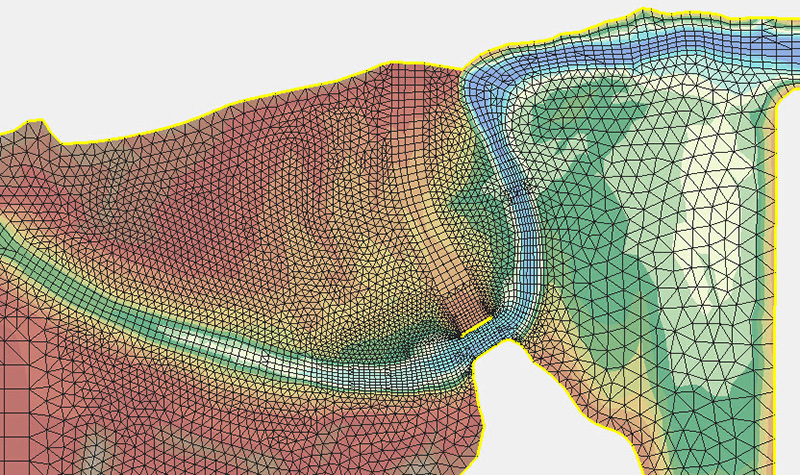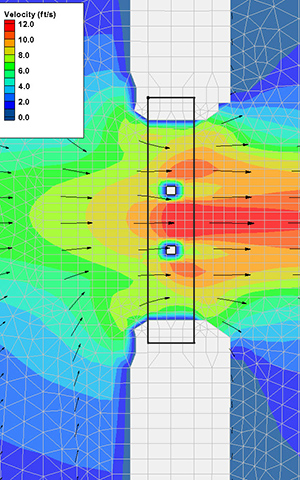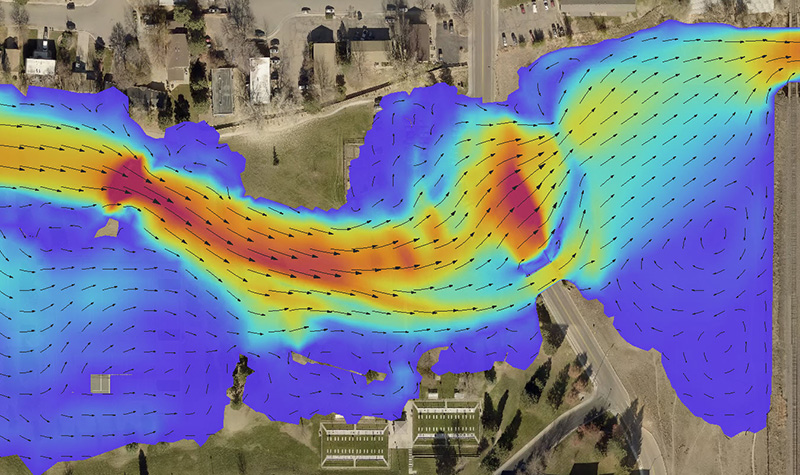FHWA Publishes Reference for 2D Hydraulic Modelers
In recent years the popularity of 2D hydraulic modeling has grown, thanks in part to the fact that newer versions are easier to use and are helping modelers better communicate complex hydraulic concepts of real-world river systems.

About the Expert:
Dusty Robinson, PE, is a water resources engineer in Ayres’ Fort Collins office. He has been working on river-related projects since 1998, with a primary focus on river engineering studies.
What are the applications for 2D models?
Gradually assuming the role of default tool for hydraulics analysis, 2D modeling is preferred by an increasing number of transportation agencies and engineering consultants who rely on it to analyze a broad spectrum of studies. 2D models are often applied to transportation hydraulics, bridge scour analysis, flood control design, river restoration, habitat evaluation, floodplain mapping, and more. However, 2D models truly hit their stride when used to calculate and visualize complex hydraulics like those found in wide, shallow floodplains; areas of varied velocity like meandering channels; and split flow scenarios such as multiple bridge openings in a roadway crossing.

FHWA initiative encourages 2D modeling
The Federal Highway Administration (FHWA) encourages use of 2D modeling through its initiative, “Collaborative Hydraulics: Advancing to the Next Generation of Engineering (CHANGE).” The program supports 2D modeling through technology transfer, training, and tutorials including a recently published reference document that offers expert insight and practical direction for 2D modelers. Focusing on 2D modeling as it applies to transportation projects, Two-Dimensional Hydraulic Modeling for Highways in the River Environment is collaboratively authored by water resources engineers and experts from the FHWA, Ayres, Aquaveo, and Northwest Hydraulic Consultants.

Better information equals better outcomes
The first federal publication to offer such content, the 301-page document provides 2D modelers with important background information, data requirements, and best practices for mesh development. With this publication, engineers now can access the information needed to plan, develop, and run a 2D model and use the results to support project design.
The publication includes sections on 2D modeling fundamentals; data and modeling requirements; 2D model development process; hydraulic structure features; land-use types; monitoring points and lines; model control and execution; model review and calibration; presentation of results; and many more.
Knowledge needed for effective use of 2D technology
Compared to 1D models, 2D models make fewer simplifying assumptions. Instead, 2D models calculate parameters like flow direction and paths, flow contraction and expansion through bridges, water surface elevation, and several others, for a more accurate representation of complex hydraulic conditions encountered in the real world.
It’s important to keep in mind, though, that 2D technology is still basically a tool in the hands of the modeler. To apply it well and achieve useful results, users need a solid understanding of hydraulics and related disciplines, and are advised by the FHWA to remember:
- 2D models eliminate numerous assumptions required by 1D models.
- Acquiring accurate terrain data and developing a representative mesh is one of the most important steps.
- 2D models don’t necessarily need more terrain data to provide better results.
- Modelers should be able to identify and represent primary hydraulic controls in the mesh.
- Before starting a new model, the modeler should be able to answer, “What is this model for?” which directs the entire model development process.
- Mesh element faces should align with hydraulic controls.
- Modelers should seek to develop an efficient mesh/model.
- Calibrating a model to known data (or sensitivity testing in the absence of known data) is an important step in developing a useable hydraulic model.
Check out our River Engineering + Water Resources division for more information.

 By
By
Post a comment: